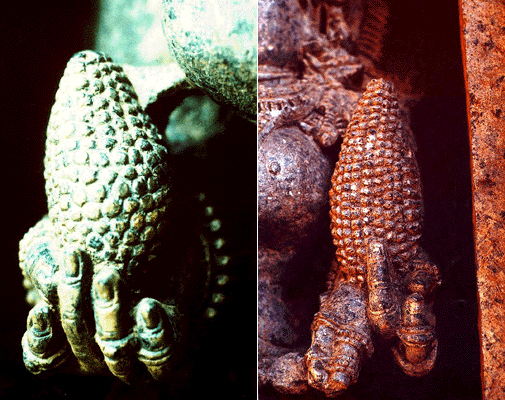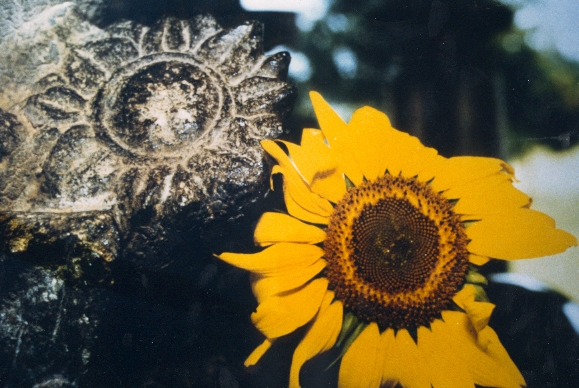Maize in Ancient India
BY: J.H. McCULLOCH

Jun 18, PORTLAND, OREGON (SUN) Maize Ears Sculptured in 12th and 13th Century A.D. India as Indicators of Pre-Columbian Diffusion.
Ethnobotonists and other Indologists and researchers have debated in published articles and research whether or not various plants believed to have originated in the New World actually had their genesis in India.
Indologist and Ethnobotanist Shakti M. Gupta of Delhi University confirms the presence of maize and at least five other New World plants in pre-Columbian temple sculptures in India in her new book, Plants in Indian Temple Art (B.R. Publishing Corp, Delhi).
Maize had previously been reported in several Hoysala temples
by Carl Johannessen and Anne Z. Parker. Vocal critics of Johannessen and Parker have argued that it was their lack of understanding of the intricacies of Hindu iconography that prevented them from realizing that what is depicted in these sculptures is in fact not maize, but rather something else - variously muktaphala (lit. "pearl-fruit",
an imaginary fruit made of pearls), some exotic tropical fruit,
or even, by one account, the Kalpavrksha, a mythical wish-granting tree (!).

Gupta’s earlier books, including Plant Myths and Traditions in India (1971), Vishnu and His Incarnations (1974), Legends around Shiva (1979), and Festivals, Fairs, and Fasts of India (1990), establish her as an authority on Indian mythology and, in particular, the role of plants in Indian history. Now, she has provided a definitive text identifying some 70 varieties of plants depicted in Hindu, Jain, and Buddhist temple art in India.
Prof. Gupta writes:
Different varieties of the corn cob [Zea mays Linn.] are extensively sculpted but only on the Hindu and Jain temples of Karnataka. Various deities are shown as carrying a corn cob in their hands as on the
Chenna Kesava temple, Belur. The straight rows of the corn grains can be easily identified. In the Lakshmi Narasimha temple, Nuggehalli, the eight-armed dancing Vishnu in his female form of Mohini is holding a corn cob in one of her left hands and the other hands hold the usual emblems of Vishnu. .... In the Trikuta basti, Mukhamandapa, Sravanbelgola, Karnataka, a 12th century A.D. sculpture of Ambika Kushmandini sitting on a lotus seat under a canopy of mangoes holds in her left hand a corn cob. Plate 223 depicting a Nayika holding a corn cob in her left hand is from Nuggehalli, Karnataka.
Temples where the sculptures of corn cobs are found are dated 12-13th century A.D. The common belief [!] is that maize originated in Mexico and came to India by the 11th-12th century. By the time these temples were constructed, maize would have been fairly common in India. (p. 176).
Gupta does not stop with maize, but goes on to identify sunflower, pineapple, cashew, custard apple and monstera, all new world species, in pre-Columbian temple art.

She finds Sunflower (Helianthus annuus Linn.), a native of Central and South America, in the Rani Gumpha cave, Udaigiri, 2nd century B.C. (p. 30). Pineapple (Ananas cosmosus [Linn.] Merrill), a plant indigenous
to Brazil, is, according to Gupta, "clearly depicted" in Udayagiri
cave temple, Madhya Pradesh, circa 5th century A.D. (p. 18).
Cashew (Anacardium occidentale Linn.), a native of Brazil, is
depicted in a Bharhut stupa balustrade relief, circa 2nd century
B.C. (p. 17). Gupta finds custard apple (Annona Squamosa Linn.)
sculpted at Bharhut, circa 2nd century B.C., and at Kakatiya,
Karnataka, 12th century A.D. (pp. 19-20). According to the
Encyclopaedia Britannica, this plant is native to the
New World tropics and Florida. And finally, monstera (Monstera
deliciosa Liebm.), also known as split leaf philodendron, a large
evergreen climber native to Central America, appears in Hindu and
Jain temples in Gujarat and Rajastan from the 11th to 13th centuries (pp. 108-9).
According to Gupta, the chili pepper (Capsicum annuum Linn.) is mentioned in the Siva and Varmana Puranas, circa 6-8th centuries A.D. Unfortunately she does not give page references or indicate the term used for it there, and the only temple carving she has found of it dates to the 17th century A.D. This very important native of Mexico and Latin America deserves further investigation.
The naga lingham, the flower of the South American and West
Indian cannonball tree (Couroupita guaianensis Aubl.), was,
according to Gupta, "cultivated in India from very early times."
In her timeframe, this would mean very early pre-Columbian times.
She notes that it figures into the worship of Shiva at several
temples. Nevertheless, the only sculpture of it she shows again
dates from the 17th century A.D. This plant also merits further research.
Gupta’s book contains a wealth of evidence for pre-Columbian
contacts between the New World and the Old, despite the fact
that she is not particularly interested in, or even aware of,
the possibility. She does repeatedly reject reports that
such-and-such plant was introduced by the Portuguese in the
16th century, but in her conclusion suggests that perhaps
plants such as the pineapple and custard apple "were indigenous to India."
Despite the "common belief" that maize was brought to India from Mexico prior to the construction of the Hoysala temples, she reports that "Maize is also believed to have an Indian origin..." It is my understanding that this is botanically impossible, although it is quite conceivable that maize was present in the subcontinent for many centuries before the Hoysala dynasty, and that distinctively Asian varieties were developed early on.
Despite Gupta’s confirmation of maize in the Hoysala sculptures, she argues that the similar but
distinctly squatter objects that appear in earlier sculptures are
not maize but rather Citron (Citrus medica var. Limonum of Watt.) or
Lemon (Citrus limon [Linn.]), both Old World plants (p. 53).
Perhaps so, but it is noteworthy that the "citron" she says is
held by a Yaksha in an 8th century A.D. sculpture from Aihole
has kernels aligned in maize-like rows. A citron looks like a
large lemon with a deeply puckered skin, but the puckering is
random, and does not simulate maize kernels as in her very clear photograph.
Unfortunately, Gupta makes no mention of the lively debate that surrounds the "maize ears." She also makes no mention of "muktaphala," or "pearl-fruit," the Sanskrit name said to be associated with these objects.
Source: J. Huston McCulloch
